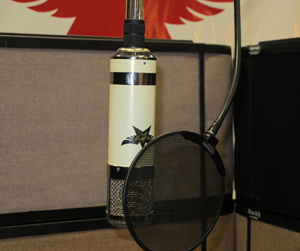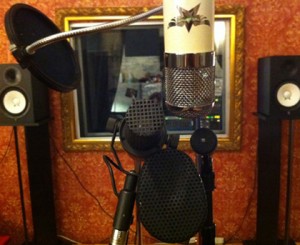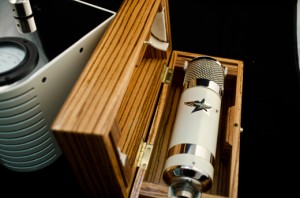Review By Shootout: The Ronin Pegasus Microphone
DUMBO, BROOKLYN: I met microphone designer Dimitri Wolfwood and his [Ronin Applied Sciences] business partner Fenton Joseph at the Tape Op party during AES New York last fall. Joel Hamilton had arrived with them and introduced us, and Dimitri immediately took me into his world of ultimate microphone design. Before I knew it, I was swept up in his excitement about capsules and transformers, the virtues of film caps, and the sin of electrolytics.
In his introduction, Joel spoke with excitement about these guys having a new approach to tube microphone design, that – to his ears – had achieved a level of complexity and balance he’d only known from the Neumann classics.
I talked microphones with Dimitri for a while that night, and we kept in touch. After a couple more conversations, I asked him if I could demo his first microphone, the Pegasus. He and Fenton arrived at the studio just as I was setting up for a session, helped set up the mic, and then set me loose.
A Few Words For The Uninitiated…
Large diaphragm condenser (LDC) microphones, especially those powered and amplified by a tube, tend to be more subjective sound transducers. Much more than most small diaphragm mics, a tube LDC traditionally exhibits a strong personality, for which you pay to some degree in “accuracy.” However, when that personality is paired up with the right source, the recording takes on a hyper-reality that can be gripping and emotional.
Traditionally, the small diaphragm condenser, and the tradition of FET-based electronics, has been a quest for different types of accuracy. The tube LDC is the one that’s always strived for character and attitude. In so doing, they wind up being useful for a different type of application.
As an extreme example, measurement microphones have a flat EQ response from a couple Hertz to 20 kHz and beyond – but the results are often “unmusical”. A tube LDC, on the other hand, usually makes no pretense towards flat response, but rather boasts an ability to give a living, interactive response to the source, not unlike a guitar amp gives the guitar and guitarist. Accuracy really has little to do with it: the question is whether its distinct personality relates well to the instrument, like when two people meet each other.
Another side-note about tubes: Tubes have a reputation for being the choice when you want “warmth” or “good distortion.” This is a poor generalization, and one that doesn’t help us understand the Pegasus. While some tube circuits can sound very good when operating in their non-linear (distorted) regions, there are as many exceptions as there are examples. First, tube distortion is not always pleasant or warm, let alone the right choice for the application. Additionally, some tube circuits sound unusably terrible when they distort, sometimes even being a frigid opposite of what is commonly mis-described as “tube warmth.”
Second, some tube equipment, including the Pegasus, can be stunningly linear, and require as much effort to be pushed into the non-linear region as any solid-state circuit. So the choice of tubes over transistors is only in part about distortion: from the point of view of the microphone designer, it’s more about choosing a particular tradition of priorities in signal amplification.
Where the Rubber Meets the Road
I tested the microphone at Vinegar Hill Sound, where I engineer and produce records along with studio owner and engineer Justin King. Our live room is about 400 square feet with 18-foot ceilings. Two walls are exposed, rough brick walls; one is drywall, and one is cloth-covered broad-band absorption. We have worked to achieve good spectral and temporal balance within the room’s natural medium-length reverb, and it is a pronounced feature of the room.
We work in Pro Tools HD 9 and use a Toft 32-channel ATB board for monitoring and mixing, but we track through outboard pre’s – API, Neve, Manley, Telefunken, Chandler – through outboard processing, and then feed directly into Lynx Aurora converters.
The Ronin Pegasus Test Sessions
To evaluate, I tested the Pegasus on various sources: voice, drum kit, kick drum, cello, trumpet, melodica, harmonica, piano, and pump organ (I will not discuss all of these). The microphones I compared it to were two tube LDC’s: the Telefunken Elektroakustik ELA-M 251E reissue and the Telefunken R-F-T AK-47; as well as mics of differing architectures: a Coles 4038 ribbon, a Telefunken ELA-M 260 SDC (reissue), a Neumann KM184 SDC, and a Shure SM7 dynamic.
On Vocals…
The first source I tried was voice. I tracked vocals for Diamond Doves singer-band-members Nick Kinsey, Wyndham Boylan-Garnett, and Brigham Brough. Each of the three trade off singing lead vocal for each song, so we had to do the “usual suspects” mic shoot-out for each of their three different voices. This was a stark demonstration of the characteristics of each microphone. We tried the Pegasus, the Telefunken ELA-M 251E, the Telefunken R-F-T AK47, and the Shure SM7 (a dynamic mic).

Diamond Doves is a trio of musicians from Elvis Perkins' band (the "Dearland" of "Elvis Perkins In Dearland")
What the Pegasus brought to each voice was musicality and balance: a robust low-end with formidable, but not overwhelming proximity effect; substantial body and detail in the lower-mids; a clarity and depth to the upper-mids, and an extended but well-tempered high-end that faithfully celebrated the higher-order harmonics.
The Telefunken 251E was by far the most similar example, but it had its own character that felt like a different take on the same subject; a more exaggerated proximity effect which made it a little more unruly (and more hyper-realistic), a similar depth to the lower mids, an upper-mid focus that was about half-an-octave higher than the Pegasus, and a sparkly high-end that nevertheless remained on a tighter leash than with the Pegasus. Transients were also a little more “gooey” than the Pegasus.
Neither of these two mics ever sounded like they got pushed into that resonating acoustic-distortion that lesser mics revert to under pressure. They remained open and tolerant of high sound pressure levels as well as ultra-resonant sources.
The Telefunken AK47, on the other hand, was much easier to push into its own resonance. It is a generally brighter mic with less depth and subtlety than the Pegasus, or the 251 for that matter. It has a bit of high-mid hype that can get edgy, which can be useful for pulling out nice natural distortions in vocals. As it happened, that was just what the doctor ordered for Nick’s voice, which has a gritty texture in that territory that distorted nicely with the AK47’s own grit – the two jousted together for a well-formed acoustic-electric distortion that became very flattering. But on Brigham’s Barry White-type baritone, it peeled the highs away into their own separate texture, where they laid distracting and out-of-balance. Likewise, Wyndham’s Brian Wilson-esque falsetto and soaring highs were dragged from sparkly to screechy through the AK47.
This edgy high-end raspiness also seemed to mask low-level information, especially in that range. So instead of casting a three-dimensional image with foreground, midfield and background, as the Pegasus and the 251 did, it depicted a much flatter image with less subtlety.
The SM7 suffered from some of the same problems; but what it lacked in complexity and easily-conjured resonance, it made up for with its characteristic impact and strength. It is a different type of mic that does a different type of thing; but it does it very well. The SM7 gives the transients a rougher handling that nevertheless glues the sound together in a lovely way – an inexact explosive intensity that replaces clarity and depth as the feature presentation. It can get a tiny bit boxy when people start to howl. But I have always found that what the SM7 lacks in precision sonics, it nevertheless imparts by offering the ear a robust landscape to re-imagine those lost details.
The Pegasus sounded universally beautiful on all three singers. It captured the three voices’ low-end weight, mid-range details and high-end harmonics with authority; In spite of that, it was not always the best fit among the group. I chose the Pegasus for Wyndham’s higher voice, but the AK47 and SM7 were much more flattering to Nick’s alto, and the ELA-M 251E had just the right mid-high-end sheen to balance Brigham’s “Papa Bear” baritone.
Pegasus on Strings
The second source I tried the Pegasus on was cello. The night consisted of string section overdubs for singer/songwriter Erin McKeown. I have had success before miking cello with a vintage U47, which brings out the creamy mid-range lushness of the wood, and the depth and size of the instrument; other times, I have used an Electro-Voice RE20 to great effect, getting a tight low-end impact without the bloated, proximity-effect lows becoming overwhelming. But, here, the Pegasus was stunning in the extension and detail of the instrument’s high-end information, couched in a rich, comfortable, and understated low-end.
I have never heard the detail in the rosin and strings emerge with such elegance and complexity, and somehow, those airy, effortless highs were well-merged with the lows and lower-mids to form a very unified sound. The Coles 4038, in comparison, was slow to respond to the harmonics, and only seemed to bring out the velvety lows and mids without addressing the highs. I even tried a high-end shelf boost to bring them out, but the sound never had the wide-spectrum of the Pegasus. They appeared, but seemed to be an after-thought. However, on the violin and viola the 4038’s sounded absolutely regal (unfortunately, there was no time to try the Pegasus on them).
On Drums…
When it came to recording drums for the Diamond Doves, I set up the Pegasus and the ELA-M 251E to be coincident for an old-fashioned shoot-out. I flipped them into omni, and placed them to be mono kit mics. This was another very interesting experiment that demonstrated the capabilities of both mics to take in a lot of information.
The Pegasus had a tighter low-end response, while the 251 has a more sizeable bottom. The Pegasus gave a good deal of focus on the lower and “mid”-mids, from about 500 Hz right on up to a little over 3k, whereas this region was more taught and scooped with the 251. The Pegasus then backed off from there to 8kHz, leaving the cymbals smoother, and rendering the transient mid-highs more realistically. Then the Pegasus had an extended crispness to the high end, up beyond the frequencies this engineer can still hear. The 251 had a gentle rolloff to the high-highs, maintaining a focus on the lows and the mid-highs from 4-8k.
Finally, the transient response between the two was noticeably different – the Pegasus had substantially more stick and batter-attack than the 251, leaving me with a little more of the drummer in the picture. The 251 seemed to get the explosion of the skin without as much information on the thing used to set it off.
With singer/songwriter Keith Polasko, I turned the Pegasus to another usual LDC task: the Kick-Out microphone. I set it about three feet in front of the kick drum inside a makeshift tunnel of insulation panels and blankets. Again, I was struck by the complexity: I could hear the detailed skin of the batter head and the body of the resonating shell as a unified panorama, with neither element competing with the other. Various bands of information lay side-by-side in perfect harmony. I needed no EQ and mixed to taste with a Beta 91 as Kick-In.
On Overdubs (Horns, Melodica, Etc.)
I conducted my fourth round of experimentation during overdubs for Chris Harford‘s upcoming record, Lay the Passage. Ween bass-player Dave Dreiwitz came in to play trumpet, harmonica and melodica over a couple different tracks. The two serious contenders were the Pegasus and the Coles 4038.
With trumpet, the Pegasus’ focus was on the delicacy of the airflow, the higher-order harmonics emanating from the bell, and the resonance of the brass. It was a bright and airy sound that stood in stark relief against the dark and creamy Coles, which focused more on the girth of the low-mids and fundamentals of the brass. For this particular song, the upper-range space the Pegasus highlighted was already firmly owned by banjo and percussive close-miked acoustic guitar, so I chose the mic that held the harmonics in tight rein – the rich Coles 4038 ribbon. But I can imagine that for the right type of music, perhaps up-tempo Latin Jazz or Ska, the Pegasus would deliver the brightness and aggression of trumpets without getting harsh and spitty like many LDC’s.
Harmonica was too honky for the Pegasus to do much with – it was the one instrument where I simply did not like the Pegasus’ response.
The biggest surprise for me was using the Pegasus with Dave playing a cheap melodica – an instrument that seems to have very little complexity to its sound. But through the Pegasus, it became a far richer instrument than it sounded in the room, which was a real brain-teaser for me. Somehow we were getting more information out of the system than we were putting in, which violates many of the principles I take for granted. It became a very artful pad with several different and distinct layers of material in the sound, each with their own winding movement, twisting and turning – out of a $25 plastic children’s toy! It was exciting to see the mic at its finest.
Complexity of Character
Without going into too much detail that can be found elsewhere, I learned from talking with Dimitri that the levels of complexity and low-level sensitivity of this mic are due to an extraordinary and completely rethought approach to making ultra-simple and uncontaminated circuits that are only possible using custom and cost-no-object parts. A Stephen Paul one-micron diaphragm, expensive toroidal transformers, a never-before-used inductor-loaded circuit and a never-before-used tube, film and polypro caps that cost up to $50 a-piece: These are the elements that go into a mic that can capture multiple zones in its dynamic range with equal musicality.
The results shine in a mic that captures complexity of character, while maintaining a balance that makes it a beautiful choice for a wide range of applications. The strength and complexity of the sound make it a unique, 21st-century addition to any great mic closet.
One thing: At $4,200, this is not a microphone for project studios. The Pegasus is only a reasonable investment for full-time engineers and producers who already have a sizeable mic closet with all the usual suspects. An engineer who is still building his mic locker would be far better off acquiring an assortment of the standard, amazing mics that cost less than $1,000.
As the saying goes, the difference between a $200 mic and a $60 mic is much bigger than that of a $200 mic and a $1,000 mic – and some cheap mics are absolutely legendary (see the SM57). But if you have all those, and you’re still looking for something different to fill out your palette, then this just may be an alternative to adding a vintage U47 or C12.
Affordability is a variable like any other, but Dimitri’s creation calls for all top-of-the-line components paired with utmost concern for elegance and functionality of design. He set out to put together his best ideas about every element of the microphone system, and use only high-quality parts to achieve an “ultimate, non-upgradeable,” and completely original microphone. The Pegasus design philosophy falls into the category of never compromising functionality for cost, and never designing by concession to either tradition or to saving a dime.
That is not for everyone, and doesn’t have to be. But for those who are lucky enough to be able to afford this mic, I’m telling you, you will know where that money went.
The Pegasus is manufactured by Ronin Applied Sciences on Long Island. Visit http://www.roninappliedsciences.com for more information.
Reed Black is an engineer, producer, musician, and songwriter based in Brooklyn. Prior to focusing on studio work, Black recorded and toured the world as keyboardist for Saves The Day and played/recorded/engineered with his subsequent eponymous band of the same members. He joined Vinegar Hill Sound as house engineer in July of 2011, where he has had the pleasure of recording for artists such as Vampire Weekend, Chris Harford, Erin McKeown, and Jeannine Hebb, among many others. Get in touch via http://www.reedblack.com.
Please note: When you buy products through links on this page, we may earn an affiliate commission.










Dreamhire
May 16, 2012 at 4:33 pm (13 years ago)If YOU (the reader) would like to demo the Pegasus – we (Dreamhire) have it to rent!
Give us a call: 212-691-5544